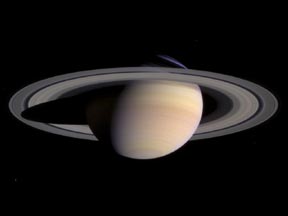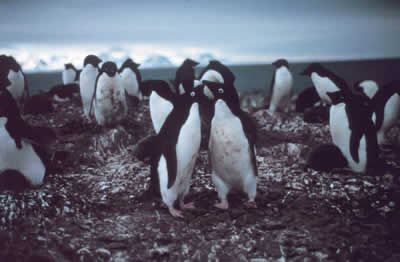This image of the planet Saturn was taken by the Cassini spacecraft on March 27, 2004. Cassini is en route to Saturn, and will go into orbit around the ringed planet early this summer.
Click on image for full size
Image courtesy NASA/JPL/Space Science Institute.
Space Day 2004
News story originally written on May 4, 2004
Each year since 1997 the first Thursday of May has been designated
as Space Day. Space Day provides us with an opportunity to celebrate interest
in astronomy,
spaceflight, and other spacey topics. This year Space Day is on May 6th.
Visit the official Space Day web site to learn more about Space Day and to
find out about events going on in your area.
You might also be interested in:

Each year since 1997 the first Thursday of May has been designated as Space Day. Space Day provides us with an opportunity to celebrate interest in astronomy, spaceflight, and other spacey topics. This
...more
Scientists have recently discovered that thousands of Adelie Penguins thrive in patches of the chilly Southern Ocean near Antarctica's coastline. In these special areas of the ocean, called polynyas,
...more
A new study has found that a mixing of two different types of magma is the key to the historic eruptions of Mount Hood, Oregon's tallest mountain, and that eruptions often happen in a relatively short
...more
Researchers have found a primitive Earth mantle reservoir on Baffin Island in the Canadian Arctic. Geologist Matthew Jackson and his colleagues from a multi-institution collaboration report the finding--the
...more
Some geologic faults that appear strong and stable, slip and slide like weak faults. Now an international team of researchers has laboratory evidence showing why some faults that 'should not' slip are
...more
It was another exciting and frustrating year for the space science program. It seemed that every step forward led to one backwards. Either way, NASA led the way to a great century of discovery. Unfortunately,
...more
The Space Shuttle Discovery lifted off from Kennedy Space Center at 2:19 p.m. EST, October 29th. The sky was clear and the weather was great as Discovery took 8 1/2 minutes to reach orbit for the Unitied
...more














